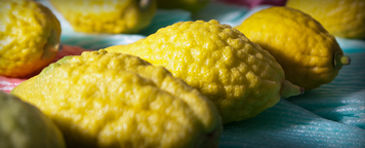
The etrog, or citron fruit in English, is one of four species that Jews are Biblically commanded to "rejoice" with during the holiday of Sukkot.
Below are 10 true and mostly joyful stories related to the etrog, shaken from the annals of the JTA Digital Archive:
[[READMORE]]
- 10. The Dalai Lama and the Papaya (1992)
If one were to show the Dalai Lama a picture of a papaya and he were to say "etrog," there’s a perfectly good explanation. During the Buddhist leader’s first visit to Brazil, he participated in an interfaith event held shortly before a major ecological conference. When the Dalai Lama entered the event’s "Jewish tent," he sang Hava Nagila and prayed for peace with Rabbi Zalman Shachter and Rabbi Henry Sobel, a leading Conservative rabbi in Brazil. Then, JTA reported, "Schachter, wearing a green suit and turban, held a small papaya fruit and palm leaf as an ecological substitute for the etrog and lulav."
- 9. Boat named ‘Etrog’ brings German reparations (1953)
Commissioned in 1950, a boat named the SS Etrog brought the first shipment of German reparations goods to Israel in 1953. The cargo included "250 tons of caustic soda and iron shipped from Hamburg." The SS Etrog sustained heavy damage in a fire that lasted 17 hours, though another freighter by the same name was commissioned in 1964. - 8. Rejected symbol of Israel (1948)
The etrog and its sukkot companion, the lulav were part of a rejected state emblem proposal for the state of Israel on the grounds that the proposed image "does not represent Israeli symbols." - 7. Salonika Jews fear Jewish-proposed etrog boycott (1931)
Following a July 1931 pogrom that left the Jewish quarter of Salonika in ruins, the international Jewish community contemplated sending a message to Greece in the form of an economic boycott. One product in particular was identified: Greek etrogim. When Greek Jews caught wind of the proposed boycott, they denounced the proposed action, fearing that it would lend fuel to the fire for anti-Jewish propogandists. An interesting case study in the clash of local and global Jewish concerns. - 6. Etrog man fights flogging in Palestine (1936)
Under British rule, JTA reported that flogging was "the most frequent punishment meted out to young offenders in Palestine." Joshua Halevi Horowitz, an etrog salesman, led a campaign against this practice. As an alternative, he proposed fining parents "for not bringing up their children properly or for not supervising their play."
- 5. Palestine chief rabbi gets British mandate to back down off of lulav and etrog ban (1929)
One year after British police clashed with Yom Kippur worshippers at the Western Wall, and just months after an Arab massacre in Hebron, the British government presumably sought to limit religious iconography in Jerusalem. Despite their attempts to enact a ban on lulavim etrogim, Chief Rabbi Abraham Isaac HaCohen Kook refused to enforce the proposed ban, calling the restrictions "medieval." Torah reading at the wall, however, was limited to the first and seventh days of Sukkot, and not the intermediary days of the holiday.
- 4. Etrog smugglers arrested (1930)
Three Jewish men were arrested for attempting to smuggle etrogim from Poland to Russia, where they were "unobtainable" for reasons not specified in our coverage.
- 3. Etrog marks the spot (Assorted)
In Peki’in, twice in Rome, and Albania, JTA has reported the etrog as a symbol of Jewish life discovered in archaeological digs.
- 2. Pesticide-free Etrog (1968)
In the U.S., Etrog imports were almost banned over a pesticide controversy:WASHINGTON, Jul. 11 (JTA) — Intervention by Agudath Israel has resulted in blocking a probable ban on the importation of ethrogim from Israel. The ethrogim are used in Sukkot observances. United States Department of Agriculture regulations had in effect, banned the import by requiring the fumigation of all citrus fruits from the Middle East in order to protect the American citrus crop from possible infestation by the Mediterranean fruit fly. Because of its sensitive nature, fumigation of the ethrog peel would have rendered it unfit for ritual use.
The use by American Jews of Israeli ethrogim was agreed to by Agriculture Department officials after proposal of an interim plan by Rabbi Moshe Sherer, executive president of Agudath Israel, calling for an examination of them in Israel by American and Israeli inspectors before shipment. Rabbi Sherer proposed that chemical testing should begin now to develop a fumigant by 1969 that would not harm the ethrog skin.
- 1. G.I. Etrog (1941-1945)
Etrog exports were critical in WWII. In 1941, one year after the Nazi blitz on London, JTA reported that etrogim were being shipped from the U.S. across the pond. In 1944, Palestine provided citron fruits to Allied soldiers in Germany. "The soldiers even had G.I. ‘Succoth,’" JTA explained, since the combination of a fox-hole and the branches overhead provided natural huts." In 1945, 100 more lulav and etrog sets were sent to Europe from Palestine, this time provided to Jews in DP camps in Germany and Czechoslovakia.
JTA has documented Jewish history in real-time for over a century. Keep our journalism strong by joining us in supporting independent, award-winning reporting.





